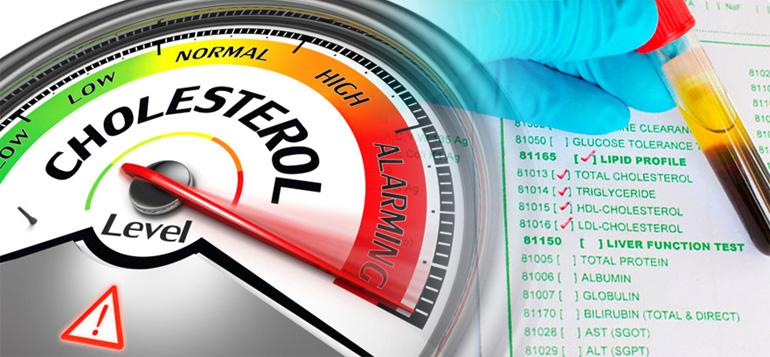Why you need to look beyond your LDL - “bad cholesterol” - level
- Published in Cardiovascular Disease

Niacin - vitamin B3 - elevates HDL levels (the "good" cholesterol) more than popular medications
- Published in Diet, Nutrition & Supplements

Low HDL-C levels are an independent risk factor for development of coronary heart disease (CHD).[1] At all levels of total cholesterol, HDL-C shows a strong inverse association with incidence of CHD. Every 1 mg/dl increase in HDL is associated with a 2-3% decrease cardiovascular risk.[1]
Among men and women aged 49-82 years, who were free of CHD at baseline, after a follow up of 12 yr, the participants with high HDL-C levels (over 60 mg/dL) had half the risk of cardiovascular events compared with participants with low HDL-C levels (below 40 mg/dL).[2] Another large study of 4,500 subjects aged 16-65 years, found after a follow-up of 6 years that individuals with HDL-C levels below <35 mg/dl were at 4 times higher heart disease risk than those with HDL-C levels over 35 mg/dl.[3]
The prevalence of low HDL levels in apparently healthy US adults is 35% in men (defined as below 40 mg/dL or 1.03 mmol/) and 39% of women (below 50 mg/dL or 1.29 mmol/L).[4] Among patients with established cardiovascular disease, 20% to 60% have low HDL levels.[5-7] Furthermore, low HDL levels are part of the criteria for the metabolic syndrome [8] and are highly prevalent among patients with diabetes, affecting more than 50% of men and 66% of women who are diabetic.[9, 10]
Statins are the most commonly used medications for heart disease. However, while statin is the most effective medication to reduce LDL (the "bad" cholesterol) levels, there remains an unacceptably high residual risk in patients who have been on statin treatment. Even after intensive statin treatment that has achieved very low LDL levels, morbidity and mortality rates among statin-treated patients still remain approximately two thirds to three quarters of those found in patients who were getting placebo.[11, 12] This large residual risk clearly indicates that LDL only modestly impacts atherosclerosis at best. Therefore, medical research is investigating HDL elevating treatments with the aim to reduce residual risk, and prevent development of cardiovascular diesase in the first place.
Blood Cholesterol Testing - don't let the routine standard lipid panel fool you!
- Published in Cardiovascular Disease

Testosterone Replacement Therapy (TRT) in Testosterone Deficient men - effects on fat loss, waist reduction and metabolic syndrome components
- Published in Testosterone Replacement Therapy

Testosterone deficiency in men, aka hypogonadism, is associated with increased total and abdominal fat mass, and reduced muscle mass, which negatively impacts body composition.[1, 2] This contributes to development of risk factors like insulin resistance, chronic inflammation, and atherogenic dyslipidemia (a triad of increased blood levels of small, dense LDL particles and triglycerides, and decreased levels of HDL particles), which increase the risk for cardiovascular disease, metabolic syndrome and diabetes.[1, 3-16]
Previous studies have shown that testosterone replacement therapy ameliorates these risk factors in testosterone deficient (hypogonadal) men; it increases insulin sensitivity [17-20] and HDL (the "good" cholesterol) [9, 10, 20, 21], and reduces waist circumference [9, 20, 22], fasting blood glucose [9, 20] triglycerides (blood fats)[9], LDL (the "bad" cholesterol) [19, 22-24], and several inflammatory markers.[17, 25]
A 2011 meta-analysis concluded that testosterone replacement therapy improves metabolic control, as well as reduces abdominal obesity.[9] Many studies have shown that testosterone replacement therapy in hypogonadal men increases muscle mass and reduces fat mass.[19, 26-32] Further, adding testosterone (50 mg/day for 1 year, administered as a transdermal gel) to a diet and exercise program results in greater therapeutic improvements of glycemic control and reverses the metabolic syndrome.[20]
Testosterone also has direct (non-obesity mediated) beneficial effects on many metabolic and cardiovascular risk factors [12, 33-37], and reduces death risk independently of body fat status.[38] In line with all these effects, low testosterone levels are associated with increased risk of cardiovascular complications [39], and all-cause and cardiovascular disease death [40-42]. Low testosterone may thus be a predictive marker for men at high risk of cardiovascular disease.[41] In a group of men aged 50-91 who were followed for 20 years, it was found that men whose total testosterone levels were in the lowest quartile (241 ng/dl or lower) were 40% more likely to die than those with higher levels, independent of age, adiposity, lifestyle or presence of cardiovascular risk factors.[38]
Thus, treatment of testosterone deficient men with testosterone has demonstrated considerable health benefits. Despite this, critics state that most of the studies on testosterone replacement therapy were too small. They also argue that the studies were of too short duration (most of them lasting 6-12 months), and that the long-term effects of testosterone on body composition are not known.
Two 5 year long studies were just published that addressed the duration and small study size shortcomings in previous research...
Effects of 6-year Long-Term Testosterone Replacement Therapy (TRT) in Patients with ‘‘Diabesity’’
- Published in Testosterone Replacement Therapy

March 6th 2014 FDA approved Aveed for treatment of male hypogonadism, aka testosterone deficiency.[1] Aveed is a long-acting form of injectable testosterone called testosterone undecanoate. In Europe, testosterone undecanoate (under the name Nebido) has a long successful TRT track record for treatment of testosterone deficiency and its consequences (especially obesity, the metabolic syndrome and diabetes).[2-16]
In contrast to shorter acting forms of testosterone (e.g. cypionate), testosterone undecanoate only needs to be injected every 6 to 12 weeks, and thereby offers practical benefits to patients. (Comment: for Nebido (1000 mg per 4 ml) the initial interval is 6 weeks, followed by intervals of 10-14 weeks; for Aveed (750 mg per 3 ml) the initial interval is 4 weeks, followed by 10-week intervals).
Five days after the FDA approval a notable and impressive 6-year long TRT study was published, confirming the health benefits of TRT that have previously been found in shorter term studies... [44]



